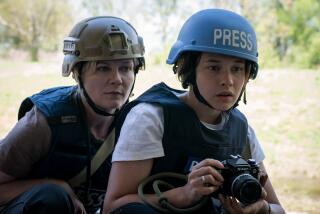Souvenirs of a More Recent War
- Share via
As I first flipped through the stack of books on the Persian Gulf War, my son looked at the pictures with me and kept asking, “Is that what it was like, did it look like that?”
Most of the time, I could safely say that I didn’t know, I hadn’t been there, but I realized that even the places that I did see at more or less the same time as the photographers looked very different on my coffee table. There are many fine photographs, but varying intensities of fear, hunger and adrenaline color my memories of these places, and that sort of personal pallet may be beyond reproduction.
The best example is the “Highway of Death,” the four-lane road running north from Kuwait City where an Iraqi convoy was trapped and annihilated. For maybe three miles, from Jahra to the crest of the Al Mutlaa Ridge, there were hundreds of vehicles of every description: tanks, Volvos, garbage trucks, armored personnel carriers, police cars. Incredibly, a few looked untouched. Many more were riddled with the lethal little holes that cluster bombs make, and others were no more than skeletal steel and puddles of liquid metal coagulating on the blacktop.
There are some horrific pictures of the corpses blackened in this caldron, the best by Jacques Langevin in the Sygma photographers’ book, In the Eye of Desert Storm: Photographers of the Gulf War (Harry N. Abrams/Eastman Kodak: $39.95 cloth; $24.95 paper). As powerful as they are, Langevin’s stomach-turning shots miss both the enormity of the destruction and the details I found so telling: unopened packages of Beatles T-shirts strewn on loose ammunition; a bolt of purple sequined cloth unfurled across the remains of a tank.
Efforts to step back are even more disappointing. The best is an aerial view of the highway by Eddie Adams that’s also in the Sygma book, but much of the impact is lost because the picture was taken long after Allied engineers began clearing the road.
It is entirely unfair to criticize these photographs because they’re not congruent with my own recollections; Langevin’s in particular are superb. If you’re willing to take the word of a radio reporter unschooled in such judgments, Langevin’s pictures of the dead on the highway will form part of the collective memory of this war, along with Detroit Free Press photographer David C. Turnley’s photograph of the grief of an injured GI in a helicopter upon learning that his friend has been killed, and AP photographer Doug Mills’ wrenching portrait of the family of Marine Capt. Jonathan Edwards at his burial; grief again. None of the collections they’ve been published in are likely to acquire that status.
The problem the Gulf War books have in common lies in their nature as instant histories--these books appeared within weeks, at the most months, after the end of the war. The speed of production gives their writers very little advantage over the journalists who are supposed to write the first draft of history.
That said, CNN War in the Gulf: From the Invasion of Kuwait to the Day of Victory and Beyond by Thomas B. Allen, F. Clifton Berry and Norman Polmar (Turner Publishing: $19.95) is by far the best of the lot, though the network’s war-coverage logo on the cover initially makes it appear the most dated of all. Instead of using its own staff to produce a book, CNN had the good sense to hire defense consultant and author Norman Polmar, F. Clifton Berry, editor of National Defense magazine and Thomas B. Allen, an author and former associate chief of National Geographic’s book division. The book provides some of the historical context the network was criticized for skimping on during the war itself, and though “CNN War in the Gulf” goes a long way out of its way to promote the virtues of Ted Turner’s all-news network, it will likely stand as the best of the capsule histories until the real thing comes along.
Triumph in the Desert: The Challenge, the Fighting, the Legacy, edited by Ray Cave and Pat Ryan (Random House: $25), tries a slightly different approach, with a narrative by Peter David, international editor of the Economist, tying together several vignettes. In one, C. D. B. Bryan uses recollections of the young, relatively thin lieutenant colonel whom he interviewed for his Vietnam War book “Friendly Fire” to write a glowing portrait of Gen. Norman Schwarzkopf; in another, David Turnley writes an account of how he took his famous picture. Throughout, from Gen. Colin Powell’s introduction to David’s final stirring sentence, “Triumph” suffers from its uncritical enthusiasm for American and Allied accomplishments. It is more a semi-official celebration than a history, but stylishly done.
Witness to War: Images From the Persian Gulf War From the Staff of the Los Angeles Times (Los Angeles Times/Times Mirror Co.: $16.95) has almost no text at all; it is a diary, consisting of pictures of the Los Angeles Times front page on each day of the war, accompanied by computer graphics, maps and photographs. The visuals are well done, but the treatment of the newspaper’s principal product is strange to say the least. The back page of the book extols the “encyclopedic breadth as well as the reportorial depth” of The Times’ coverage of the war, but we don’t get to read any of it.
Eye of the Storm: Images of the Persian Gulf War by Knight Ridder Photographers, edited by Randy Miller and written by Gary Blonston (Knight Ridder: $14.95) and Sygma’s “In the Eye of Desert Storm” are so complementary that a way should have been found to combine them. Operating under the infuriating combination of restrictions and access provided by the Defense Department’s media pools, the Knight Ridder material is virtually all American. Sygma, excluded from U.S. pools, is heavily weighted toward the allies. Due in part to that novelty, I found Sygma’s “In the Eye of Desert Storm” the more interesting.
Taking these books together, it’s curious that there are so few pictures of actual combat. There are a lot of reasons for that--access was restricted, the air war was impossible to get to, the ground war lasted just four days--but perhaps military photographers or the soldiers themselves did better. Even more important, there are almost no pictures or reportage from the other side, where Western journalists were rarely allowed and were always escorted by government minders.
It’s hard to imagine that Iraqi reporters and photographers are producing the same kinds of books in Baghdad, but much of the drama and most of the tragedy of this war occurred behind Iraqi lines, and there can be no pretense of any objective account of it until we learn what happened there.
More to Read
Sign up for Essential California
The most important California stories and recommendations in your inbox every morning.
You may occasionally receive promotional content from the Los Angeles Times.










